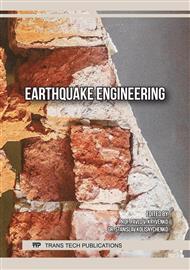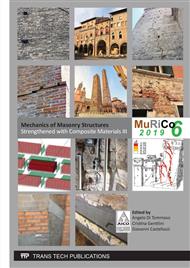p.605
p.613
p.621
p.627
p.634
p.642
p.650
p.659
p.665
Post-Cracking B-FRCM Strengthening of a Traditional Anti-Seismic Construction Technique (Casa baraccata): Extensive Experimental Investigations
Abstract:
In the framework of the Mediterranean cultural heritage, the term “fictile tubule” identifies a peculiar type of brick, characterized by a cylindrical shape and a hollow core. Its unique geometry and characteristics rank it among the first hollow clay bricks in history. The large-scale production of fictile tubules allegedly began in the Roman provinces of Northern Africa during the 2nd Century A.D., where they were employed for building vaulted and domed structures without the need of centrings. Over the following Centuries, the construction technique of fictile tubules embedded in mortar was constantly refined and improved. This led to an extensive use of such technique in several buildings - as part of different structural elements (vaults, domes, floors, walls) - all over the Mediterranean area, and especially in Southern Italy. In 1909, after the disastrous earthquake in Messina and Reggio Calabria, Calabrian engineer Pasquale Frezza devised and patented an anti-seismic construction system which evolved the technology of casa baraccata. Frezza’s take on this traditional Calabrian way of erecting buildings involved the use of a specific type of fictile tubule, named carosello, alternated with common bricks in masonry walls, which are then encased in a timber frame. This paper presents an investigation on the structural behavior of Frezza’s evolution of casa baraccata, aimed at its possible revival as a relevant anti-seismic construction technique. Two specimen walls with dimensions equal to 60×60×15 cm3 are built according to Frezza’s patent and experimentally examined through a diagonal compressive test at the Civil Engineering Laboratory of University of Calabria. For the first specimen wall the test is carried out until failure to identify the collapse load. Conversely, for the second specimen wall the test is halted immediately after the formation of the first vertical cracks. The specimen is subsequently repaired using B-FRCM (Basalt Fiber-Reinforced Cementitious Matrix) as reinforcement, and the diagonal compressive test is repeated, this time until failure. The results in terms of collapse load and shear strength for both specimens are then compared and critically discussed, highlighting the increased load-bearing capacity of the wall built according to Frezza’s patent and reinforced with B-FRCM.
Info:
Periodical:
Pages:
634-641
Citation:
Online since:
August 2019
Price:
Сopyright:
© 2019 Trans Tech Publications Ltd. All Rights Reserved
Share:
Citation:



